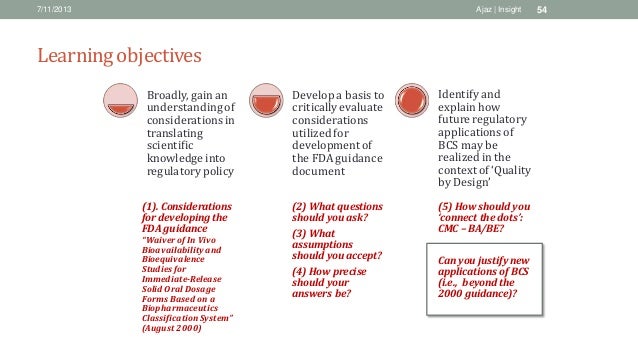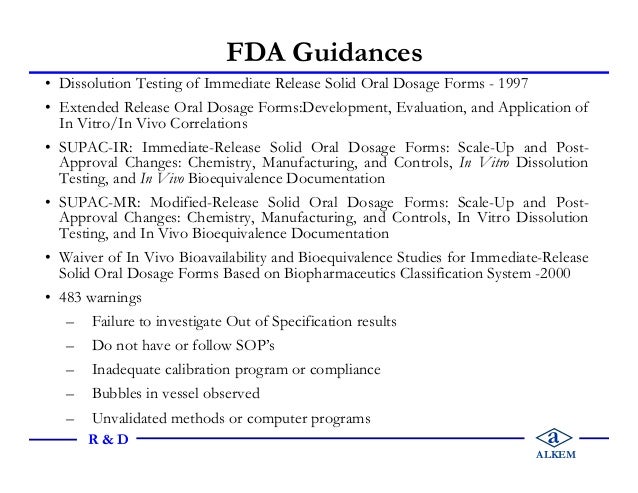Fda Guidance Bcs Classification
- Docket Number:
- 97D-0331
- Issued by:
The BCS is a scientific framework for classifying drug substances based on their aqueous solubility and intestinal permeability. 1 When combined with the dissolution of the drug product, the BCS takes into account three major factors that govern the rate and extent of drug absorption from immediate-release (IR) solid oral dosage forms: dissolution, solubility, and intestinal permeability.

The Food and Drug Administration (FDA) is announcing the availability of a guidance for industry entitled ``Dissolution Testing of Immediate Release Solid Oral Dosage Forms.' The purpose of this guidance document is to provide general recommendations for dissolution testing, approaches for setting dissolution specifications related to biopharmaceutic characteristics of the drug substance, statistical methods for comparing dissolution profiles, and a process to help determine when dissolution testing is sufficient to grant a waiver for an in vivo bioequivalence study. This guidance document also provides recommendations for dissolution tests to help ensure continuous drug product quality and performance after certain postapproval manufacturing changes.
Submit Comments

You can submit online or written comments on any guidance at any time (see 21 CFR 10.115(g)(5))
If unable to submit comments online, please mail written comments to:
Division of Dockets Management (HFA- 305)
Food and Drug Administration
5630 Fishers Lane, Rm. 1061
Rockville, MD 20852
All written comments should be identified with this document's docket number: 97D-0331.

Regulated Product(s)
An Industrial Implementation of the Biopharmaceutics Classification System
Jack A. Cook, Ph.D. and Howard N. Bockbrader, Ph.D.
Clinical Pharmacokinetics and Pharmacodynamics Department,
Pfizer Global Research and Development, Ann Arbor, MI
Introduction
In 1995 Amidon et al. devised a biopharmacetics classification system (BCS) to classify drugs based on their aqueous solubility and intestinal permeability(1). It was then recognized that dissolution rate has a negligible impact on bioavailability of highly soluble and highly permeable (BCS Class I) drugs when their formulation's dissolution is sufficiently rapid(2). As a result, various regulatory agencies including the United States Food and Drug Administration (FDA) now allow bioequivalence of formulations of BCS Class I drugs to be demonstrated by in vitro dissolution (often called a biowaiver)(3,4). This paper examines one approach to the integration of the biopharmaceutics classification system in drug development.
Potential Cost Savings
Before attempting to implement any new paradigm, it is prudent to examine the potential savings of the paradigm relative to the costs of implementation. The potential savings is a function of the potential number and likely cost of bioequivalence studies saved (not performed). The cost of implementation is a function of the number and the costs of compound and formulation characterizations.
To examine the potential savings, the number of bioequivalence studies performed by the pharmaceutical industry per year was examined. Between January 1998 and May 2001, there were 229 New Drug Applications (NDAs) and 466 Abbreviated New Drug Applications (ANDAs) approved by the FDA for oral immediate release products (5). Recently, DiMasi noted an approval rate of approximately 90% for NDAs (6). Assuming similar approval rates for ANDAs, annual submission rates over the same period were 74 NDAs/year and 152 ANDAs/year. The Product Quality Research Institute has noted that the average NDA submission contains 3 to 6 in vivo bioequivalence studies (7). If one assumes that ANDAs contain 1 in vivo bioequivalence study, this suggests that industry performs approximately 350 to 600 bioequivalence studies each year. The authors have estimated that a typical bioequivalence study costs approximately $250,000 including costs for packaging, clinical facilities, data internalization, bioanalytical analysis, pharmacokinetic and statistical analysis, and report generation. Thus, it is estimated that the pharmaceutical industry spends between 90 and 150 million dollars a year on bioequivalence studies. Further, this must be recognized as an underestimate as the data does not capture bioequivalence studies performed on drugs for which NDAs or ANDAs are never filed.
To determine the fraction of drugs likely amenable to biowaivers, NDAs for oral immediate release prescription products approved between January 1998 and May 2001 were characterized based on literature data and the product label. Bluebeam product key. Each compound was counted only once when multiple formulations were approved. A compound was considered highly permeable if data existed that suggest it meets permeability criteria listed in the FDA BCS guidance (3). Data on solubility was generally limited and precluded precise classification. Therefore, a compound was classified as highly soluble if it met guidance criteria (highest dosage strength soluble in 250 mL) at one pH between 1 and 7.5 and was not precluded (i.e. highest dosage strength not soluble) from being highly soluble at some other pH.
Using the above criteria, approximately 25% of all compounds were classified as highly soluble and permeable with approximately another 41% having insufficient data to allow classification.
Using the 25% estimated above, there is the potential to save one quarter the annual expenditures on bioequivalence studies, $22 to $38 million dollars/year. Additional indirect savings can occur if bioequivalence studies are rate limiting to drug development. For example, suppose that results of a bioequivalence study are needed before proceeding with development of a compound with eventual peak sales of one billion dollars/year. It is not unreasonable to assume that results of in vitro dissolution can be obtained 6 weeks earlier than results from an in vivo bioequivalence trial. This time savings translates into a potential additional $110 million dollars in sales from a 6 week earlier approval. Further, by not having to run a human bioequivalence trial, clinical resources are freed to be applied elsewhere.
The authors have estimated that BCS characterization costs approximately $10,000 to $60,000 per compound, depending on the method used to characterize permeability. Additionally, it is estimated that it costs approximately $15,000 to characterize the dissolution of each formulation. Given that the majority of compounds are not biowaiver candidates, a strategy of formal classification of every compound in development would quickly consume and may surpass any potential savings. Thus a more targeted strategy is proposed during development to try to optimize the potential savings.
An Implementation Strategy
A targeted implementation strategy is illustrated in Figure 1. High throughput screens are used early in the drug discovery process, when series of compounds are being synthesized to elucidate structure activity relationships between compounds and the cell target (8). An initial classification for permeability is gathered using an automated permeability determination using CaCo2 on well plates. A high throughput quasi-equilibrium method solubility is performed at pH 6.5 using UV-detection. With these assays over 100 compounds can be characterized in a week. Compounds are considered likely highly soluble if the projected human dose is soluble in 250 mL of water at pH 6.5 and likely highly permeable if the CaCo2 determined permeability is greater than that of metoprolol, which was chosen as the standard by virtue of it being the high permeability drug with the lowest permeability. It should also be noted that a compound could also be considered likely highly permeable if subsequent preclinical pharmacokinetic studies result in an absolute bioavailability of 90% or more or if oral mass balance studies result in 90% or more of the total radioactive dose recovered in the urine.
Figure 1. An Industrial Implementation Strategy for the Biopharmaceutics Classification System.
Definitive BCS classification is done when a potential Class I candidate enters human testing. Classification is done according to methods outlined in the FDA guidance (3). For instance, solubility is determined at pH 1.2, 7.5 and at pHs around the compounds pKa (pKa-1, pKa, and pKa+1). In order of preference, permeability classification is determined from renal excretion data from human studies, extent of renal radioactivity excretion from human mass balance studies, human absolute bioavailability, and preclinical permeability studies (rat intestinal perfusion or CaCo2). The order of preference was derived by first noting that human data is considered more definitive than preclinical or in vitro data and second by the cost to obtain the data. If the compound meets all criteria, a petition is sent to the FDA asking for their agreement with the compounds classification. The goal is to send the petition to the FDA prior to the initiation of Phase II.
Fda Guidance Bcs Classification
As subsequent formulation development proceeds, dissolution studies are done on new formulations in accordance with the FDA guidance (3) and petitions are submitted to the FDA requesting waivers of in vivo bioequivalence studies. Use of the guidance has allowed the waiver of 4 human bioequivalence trials and a savings of approximately 1 million dollars.
Beyond Biowaivers
While savings resulting from application of the BCS to obtain waivers of in vivo bioequivalence studies are notable, they may not represent the most significant benefit from application of the BCS. Early high throughput screening information regarding solubility and permeability should be invaluable to discovery chemists. Previous authors have noted that compounds that have good solubility and permeability are much more likely to lead to an approved NDA then other compounds (9,10). Further, it has been reported that 39% of compounds in development fail because of poor biopharmaceutical properties (11). Thus consideration of BCS criteria when selecting drug candidates may have a profound impact by decreasing attrition during development.
Bcs Classification Of Drug
References
1. Amidon, G.L., H. Lennernäs, V.P. Shah, and J. R. Crison, 'A theoretical basis for a biopharmaceutics Drug Classification: The correlation of in vitro drug product dissolution and in vivo bioavailability.' Pharmaceutical Research 12 (3, March), 413-420, 1995.
2. Kaus, L.C., W.R. Gillespie, A.S. Hussain, and G.L. Amidon, 'The effect of in vivo dissolution, gastric emptying rate, and intestinal transit time on the peak concentration and area-under-the-curve of drugs with different gastrointestinal permeabilities.' Pharmaceutical Research 16 (2, February), 272-280, 1999.
3. United States Food and Drug Administration. Guidance for Industry: Waiver of In Vivo Bioavailability and Bioequivalence Studies for Immediate-Release Solid Oral Dosage Forms Based on a Biopharmaceutics Classification System. August 2000. http://www.fda.gov/cder/guidance/3618fnl.htm
4. European Agency for the Evaluation of Medicinal Products. Note for guidance on the investigation of bioavailability and bioequivalence, (CPMP/EWP/QWP/1401/98), Committee for proprietary medicinal products, July 26 2001. http://www.emea.eu.int/pdfs/human/ewp/140198en.pdf
5. United States Food and Drug Administration. CDER New and Generic Drug Approvals: 1998-2002. http://www.fda.gov/cder/approval/index.htm
6. DiMasi JA. New drug development in the United States from 1963 to 1999. Clin Pharmacol Ther 2001;69:286-96
7. United States Food and Drug Administration, Division of Product Quality Research. Biopharmaceutics Research. January 16, 1998. http://www.fda.gov/cder/dpqr/dpqr_pgm.htm
8. Surendran N, Stilgenbauer LA, Michael S, Kibbey C, Woodhams P, Stankovic C, Gifford E, Mandagere A, Quimby A, Wu S, Stewart BH. Implementation of a Process for Early ADME/PK In Vitro Profiling of New Chemical Entities in Support of Drug Discovery. AAPS PharmSci 2000 AAPS Annual Meeting Supplement. 2000; 2 (4) Available from: http://www.aapspharmsci.org/scientificjournals/pharmsci/am_abstracts/2000/162.html.
9. Venkatesh S, Lipper RA. Role of the development scientist in compound lead selection and optimization. J Pharm Sci. 2000 Feb; 89(2):145-54.
10. Lipinski CA, Lombardo F, Dominy BW, Feeney PJ. Experimental and computational approaches to estimate solubility and permeability in drug discovery and development settings. Adv Drug Deliv Rev. 2001 Mar 1; 46(1-3):3-26. (PII of original article: S0169-409X(96)00423-1. The article was originally published in Advanced Drug Delivery Reviews 1997 23:3-25).
11. Prentis RA, Lis Y, Walker SR. Pharmaceutical innovation by the seven U.K.-owned pharmaceutical companies (1964-1985). Br J Clin Pharmacol. 1988 Mar; 25(3):387-96.